Trends of High and Low Values of Annual and Seasonal Precipitation in Turkey
Abstract
:1. Introduction
2. Study Area and Data
3. Methods
3.1. Homogeneity Tests
- Classic 1:
- Useful (if one or zero tests reject the H0);
- Classic 2:
- Doubtful (if two tests reject the H0);
- Classic 3:
- Suspect (if three or four tests reject the H0) [12].
3.2. Mann–Kendall (MK) Test
3.3. Improved Visualization of Innovative Trend Analysis (IV-ITA)
4. Results
4.1. Homogeneity Test Results
4.2. Mann–Kendall Test Results
4.3. IV-ITA Results
5. Discussion
6. Conclusions
- While the MK method detected trends for only a few stations among the 156 stations, the newly developed IV-ITA method identified trends for a significantly more significant number of stations and separately determined these trends for both the high- and low-data groups. This approach provides a more detailed interpretation of trend detection and enables the detection of trends that traditional methods cannot detect;
- According to the IV-ITA method, annual trends for the low- and high-data categories ranged from −20 to 30 and −26 to 34, respectively. Conventional methods cannot graphically represent the trend variability of extreme events, such as ‘high’ and ‘low’ monthly precipitation values;
- According to the IV-ITA method for seasonal trends, different trends are detected for other data groups in different regions for each season. This result highlights the advantage of the IV-ITA method over the MK. The study has the potential to contribute to advancing trend analysis literature with its presented results, and its application to different climate parameters would yield more comprehensive and in-depth outcomes;
- For countries in the Mediterranean Basin that experience significant impacts of climate change, the IV-ITA method can be employed to investigate trends in various hydrological variables. Thus, using the IV-ITA method, the dominant climate regions in these countries will be identified based on their respective types.
Funding
Institutional Review Board Statement
Informed Consent Statement
Data Availability Statement
Conflicts of Interest
References
- Bayazit, M. Nonstationarity of hydrological records and recent trends in trend analysis: A state-of-the-art review. Environ. Process. 2015, 2, 527–542. [Google Scholar] [CrossRef]
- Chen, J.; Lyu, Y.; Zhao, Z.; Liu, H.; Zhao, H.; Li, Z. Using the multidimensional synthesis methods with non-parameter test, multiple time scales analysis to assess water quality trend and its characteristics over the past 25 years in the Fuxian Lake, China. Sci. Total Environ. 2019, 655, 242–254. [Google Scholar] [CrossRef] [PubMed]
- Luo, P.; Kang, S.; Zhou, M.; Lyu, J.; Aisyah, S.; Binaya, M.; Regmi, R.K.; Nover, D. Water quality trend assessment in Jakarta: A rapidly growing Asian megacity. PLoS ONE 2019, 14, e0219009. [Google Scholar] [CrossRef] [PubMed]
- Aydogan, B.; Ayat, B. Spatial variability of long-term trends of significant wave heights in the Black Sea. Appl. Ocean Res. 2018, 79, 20–35. [Google Scholar] [CrossRef]
- Ghafarian, P.; Tajbakhsh, S.; Delju, A.H. Analysis of the Long-Term Trend of Temperature, Precipitation, and Dominant Atmospheric Phenomena in Lake Urmia. In The Handbook of Environmental Chemistry; Springer: Berlin/Heidelberg, Germany, 2021. [Google Scholar] [CrossRef]
- Ceribasi, G.; Ceyhunlu, A.I.; Ahmed, N. Analysis of temperature data by using innovative polygon trend analysis and trend polygon star concept methods: A case study for Susurluk Basin, Turkey. Acta Geophys. 2021, 69, 1949–1961. [Google Scholar] [CrossRef]
- Madhukar, A.; Dashora, K.; Kumar, V. Climate trends in temperature and water variables during wheat growing season and impact on yield. Environ. Process. 2021, 8, 1047–1072. [Google Scholar] [CrossRef]
- Mehta, D.J.; Yadav, S.M. Long-term trend analysis of climate variables for arid and semi-arid regions of an Indian State Rajasthan. Int. J. Hydrol. Sci. Technol. 2022, 13, 191–214. [Google Scholar] [CrossRef]
- Katipoglu, O.M. Analysis of spatial variation of temperature trends in the semiarid Euphrates basin using statistical approaches. Acta Geophys. 2022, 70, 1899–1921. [Google Scholar] [CrossRef]
- Alehu, B.A.; Bitana, S.G. Assessment of climate change impact on water balance of Lake Hawassa Catchment. Environ. Process. 2023, 10, 14. [Google Scholar] [CrossRef]
- Guclu, Y.S. Improved visualization for trend analysis by comparing with classical Mann-Kendall test and ITA. J. Hydrol. 2020, 584, 124674. [Google Scholar] [CrossRef]
- San, M.; Akcay, F.; Linh, N.T.T.; Kankal, M.; Pham, Q.B. Innovative and polygonal trend analyses applications for rainfall data in Vietnam. Theor. Appl. Climatol. 2021, 144, 809–822. [Google Scholar] [CrossRef]
- Alashan, S. An improved version of innovative trend analyses. Arab. J. Geosci. 2018, 11, 50. [Google Scholar] [CrossRef]
- Akcay, F.; Kankal, M.; San, M. Innovative approaches to the trend assessment of streamflows in the eastern Black Sea basin, Turkey. Hydrol. Sci. J. 2022, 67, 222–247. [Google Scholar] [CrossRef]
- Dimitriadou, S.; Nikolakopoulos, K.G. Evapotranspiration Trends and Interactions in Light of the Anthropogenic Footprint and the Climate Crisis: A Review. Hydrology 2021, 8, 163. [Google Scholar] [CrossRef]
- Sanikhani, H.; Kisi, O.; Mirabbasi, R.; Meshram, S.G. Trend analysis of rainfall pattern over the Central India during 1901–2010. Arab. J. Geosci. 2018, 11, 437. [Google Scholar] [CrossRef]
- Mallick, J.; Talukdar, S.; Almesfer, M.K.; Alsubih, M.; Ahmed, M.; Islam, A.R.M. Identification of rainfall homogenous regions in Saudi Arabia for experimenting and improving trend detection techniques. Environ. Sci. Pollut. Res. 2021, 29, 25112–25137. [Google Scholar] [CrossRef]
- Mallick, J.; Talukdar, S.; Alsubih, M.; Salam, R.; Ahmed, M.; Kahla, N.B.; Shamimuzzaman, M. Analysing the trend of rainfall in Asir region of Saudi Arabia using the family of Mann-Kendall tests, innovative trend analysis, and detrended fluctuation analysis. Theor. Appl. Climatol. 2021, 143, 823–841. [Google Scholar] [CrossRef]
- Caloiero, T. Analysis of rainfall trend in New Zealand. Environ. Earth Sci. 2015, 73, 6297–6310. [Google Scholar] [CrossRef]
- Mondal, A.; Khare, D.; Kundu, S. Spatial and temporal analysis of rainfall and temperature trend of India. Theor. Appl. Climatol. 2015, 122, 143–158. [Google Scholar] [CrossRef]
- Nouaceur, Z.; Murarescu, O. Rainfall variability and trend analysis of annual rainfall in North Africa. Int. J. Atmos. Sci. 2016, 2016, 7230450. [Google Scholar] [CrossRef]
- Chattopadhyay, S.; Edwards, D.R. Long-term trend analysis of precipitation and air temperature for Kentucky, United States. Climate 2016, 4, 10. [Google Scholar] [CrossRef]
- Oztopal, A.; Sen, Z. Innovative trend methodology applications to precipitation records in Turkey. Water Resour. Manag. 2017, 31, 727–737. [Google Scholar] [CrossRef]
- Asfaw, A.; Simane, B.; Hassen, A.; Bantider, A. Variability and time series trend analysis of rainfall and temperature in northcentral Ethiopia: A case study in Woleka sub-basin. Weather Clim. Extrem. 2018, 19, 29–41. [Google Scholar] [CrossRef]
- Saadi, Z.; Shahid, S.; Ismail, T.; Chung, E.S.; Wang, X.J. Trends analysis of rainfall and rainfall extremes in Sarawak, Malaysia using modified Mann–Kendall test. Meteorol. Atmos. Phys. 2019, 131, 263–277. [Google Scholar] [CrossRef]
- Alsubih, M.; Kumari, M.; Mallick, J.; Ramakrishnan, R.; Islam, S.; Singh, C.K. Time series trend analysis of rainfall in the last five decades and its quantification in Aseer Region of Saudi Arabia. Arab. J. Geosci. 2021, 14, 519. [Google Scholar] [CrossRef]
- Hajani, E.; Klari, Z. Trends analysis in rainfall data series in Duhok city, Kurdistan region, Iraq. Model. Earth. Syst. Environ. 2022, 8, 4177–4190. [Google Scholar] [CrossRef]
- Sen, Z. Partial trend identification by change-point successive average methodology (SAM). J. Hydrol. 2019, 571, 288–299. [Google Scholar] [CrossRef]
- Mann, H.B. Nonparametric tests against trend. Econom. J. Econom. Soc. 1945, 13, 245–259. [Google Scholar] [CrossRef]
- Kendall, M.G. Rank Correlation Method; Charless Griffin: London, UK, 1975. [Google Scholar]
- Sen, Z. Innovative trend significance test and applications. Theor. Appl. Climatol. 2017, 127, 939–947. [Google Scholar] [CrossRef]
- Sen, P.K. Estimates of the regression coefficient based on Kendall’s tau. J. Am. Stat. Assoc. 1968, 63, 1379–1389. [Google Scholar] [CrossRef]
- Sen, Z. Innovative trend analysis methodology. J. Hydrol. Eng. 2012, 17, 1042–1046. [Google Scholar] [CrossRef]
- Sen, Z. Trend identification simulation and application. J. Hydrol. Eng. 2014, 19, 635–642. [Google Scholar] [CrossRef]
- Sen, Z. Innovative Trend Methodologies in Science and Engineering; Springer International Publishing: New York, NY, USA, 2017; pp. 1–349. [Google Scholar] [CrossRef]
- Sen, Z. Innovative Trend Analyses. In Innovative Trend Methodologies in Science and Engineering; Springer: Cham, Switzerland, 2017; pp. 175–226. [Google Scholar] [CrossRef]
- Naveed, A.; Genxu, W.; Haishen, L.; Martijn, J.B.; Hero, M.; Foyez, A.P.; Shahid, A.; Muhammad, A.I. Attribution of Changes in Streamflow to Climate Change and Land Cover Change in Yangtze River Source Region, China. Water 2022, 14, 259. [Google Scholar] [CrossRef]
- Wu, H.; Qian, H. Innovative trend analysis of annual and seasonal rainfall and extreme values in Shaanxi, China, since the 1950s. Int. J. Climatol. 2017, 37, 2582–2592. [Google Scholar] [CrossRef]
- Caloiero, T.; Coscarelli, R.; Ferrari, E. Application of the innovative trend analysis method for the trend analysis of rainfall anomalies in southern Italy. Water Resour. Manag. 2018, 32, 4971–4983. [Google Scholar] [CrossRef]
- Zhou, Z.; Wang, L.; Lin, A.; Zhang, M.; Niu, Z. Innovative trend analysis of solar radiation in China during 1962–2015. Renew. Energy 2018, 119, 675–689. [Google Scholar] [CrossRef]
- Li, J.; Wu, W.; Ye, X.; Jiang, H.; Gan, R.; Wu, H.; He, J.; Jiang, Y. Innovative trend analysis of main agriculture natural hazards in China during 1989–2014. Nat. Hazard 2019, 95, 677–720. [Google Scholar] [CrossRef]
- Wang, Y.; Xu, Y.; Tabari, H.; Wang, J.; Wang, Q.; Song, S.; Hu, Z. Innovative trend analysis of annual and seasonal rainfall in the Yangtze River Delta, eastern China. Atmos. Res. 2020, 231, 104673. [Google Scholar] [CrossRef]
- Alifujiang, Y.; Abuduwaili, J.; Maihemuti, B.; Emin, B.; Groll, M. Innovative trend analysis of precipitation in the Lake Issyk-Kul Basin, Kyrgyzstan. Atmosphere 2020, 11, 332. [Google Scholar] [CrossRef]
- Mohorji, A.M.; Sen, Z.; Almazroui, M. Trend analyses revision and global monthly temperature innovative multi-duration analysis. Earth Syst. Environ. 2017, 1, 9. [Google Scholar] [CrossRef]
- Tabari, H.; Taye, M.T.; Onyutha, C.; Willems, P. Decadal analysis of river flow extremes using quantile-based approaches. Water Resour. Manag. 2017, 31, 3371–3387. [Google Scholar] [CrossRef]
- Guclu, Y.S. Multiple Sen-innovative trend analyses and partial Mann-Kendall test. J. Hydrol. 2018, 566, 685–704. [Google Scholar] [CrossRef]
- Deniz, A.; Toros, H.; Incecik, S. Spatial variations of climate indices in Turkey. Int. J. Climatol. 2011, 31, 394–403. [Google Scholar] [CrossRef]
- Von Neumann, J. Distribution of the ratio of the mean square successive difference to the variance. Ann. Math. Stat. 1941, 12, 367–395. Available online: https://www.jstor.org/stable/2235951 (accessed on 1 September 2023). [CrossRef]
- Pettitt, A.N. A non-parametric approach to the change-point problem. J. R. Stat. Soc. C 1979, 28, 126–135. [Google Scholar] [CrossRef]
- Buishand, T.A. Some methods for testing the homogeneity of rainfall records. J. Hydrol. 1982, 58, 11–27. [Google Scholar] [CrossRef]
- Alexandersson, H. A homogeneity test applied to precipitation data. J. Climatol. 1986, 6, 661–675. [Google Scholar] [CrossRef]
- Wijngaard, J.B.; Klein Tank, A.M.G.; Können, G.P. Homogeneity of 20th century European daily temperature and precipitation series. Int. J. Climatol. A J. R. Meteorol. Soc. 2003, 23, 679–692. [Google Scholar] [CrossRef]
- Yue, S.; Wang, C. The Mann-Kendall test modified by effective sample size to detect trend in serially correlated hydrological series. Water Resour. Manag. 2004, 18, 201–218. [Google Scholar] [CrossRef]
- Hamed, K.H. Exact distribution of the Mann–Kendall trend test statistic for persistent data. J. Hydrol. 2009, 365, 86–94. [Google Scholar] [CrossRef]
- Tosunoglu, F.; Can, I.; Kahya, E. Evaluation of spatial and temporal relationships between large-scale atmospheric oscillations and meteorological drought indexes in Turkey. Int. J. Climatol. 2018, 38, 4579–4596. [Google Scholar] [CrossRef]
- Arikan, B.; Kahya, E. Homogeneity revisited: Analysis of updated precipitation series in Turkey. Theor. Appl. Climatol. 2019, 135, 211–220. [Google Scholar] [CrossRef]
- Cicek, I.; Duman, N. Seasonal and annual precipitation trends in Turkey. Carpathian J. Earth Environ. Sci. 2015, 10, 77–84. [Google Scholar]
- Touhedi, H.; Kankal, M.; Yıldız, M.B. Trend analysis of maximum rainfall series of standard durations in Turkey with innovative methods. Nat. Hazards 2023, 1–33. [Google Scholar] [CrossRef]
- Trenberth, K.E. Changes in precipitation with climate change. Clim. Res. 2011, 47, 123–138. [Google Scholar] [CrossRef]
- Gorum, T.; Fidan, S. Spatiotemporal variations of fatal landslides in Turkey. Landslides 2021, 18, 1691–1705. [Google Scholar] [CrossRef]
- Gurer, I.; Ozguler, H. Turkey: Recent flood disasters in northwestern black sea region. WMO/GWP Associated Programme on Flood Management. Integrated Flood Management: Case Study. 2004; pp. 1–20. Available online: https://www.floodmanagement.info/publications/casestudies/cs_turkey_sum.pdf (accessed on 1 September 2023).
- Haltas, I.; Yildirim, E.; Oztas, F.; Demir, I. A comprehensive flood event specification and inventory: 1930–2020 Turkey case study. Int. J. Disaster Risk Reduct. 2021, 56, 102086. [Google Scholar] [CrossRef]
- Partal, T.; Kahya, E. Trend analysis in Turkish precipitation data. Hydrol. Process. Int. J. 2006, 20, 2011–2026. [Google Scholar] [CrossRef]
- Unal, Y.S.; Deniz, A.; Toros, H.; Incecik, S. Temporal and spatial patterns of precipitation variability for annual, wet, and dry seasons in Turkey. Int. J. Climatol. 2012, 32, 392–405. [Google Scholar] [CrossRef]
- Topaloglu, F.; Ozfidaner, M. Regional trends of precipitation in Turkey. Fresenius Environ. Bull. 2012, 21, 2908–2915. [Google Scholar]
- Guner, B.U. Trend analysis of precipitation and drought in the A egean region, Turkey. Meteorol. Appl. 2017, 24, 239–249. [Google Scholar] [CrossRef]
- Hadi, S.J.; Tombul, M. Long-term spatiotemporal trend analysis of precipitation and temperature over Turkey. Meteorol. Appl. 2018, 25, 445–455. [Google Scholar] [CrossRef]
- Turkes, M.; Koc, T.; Sarıs, F. Spatial and temporal analysis of the changes and trends in precipitation total and intensity series of Turkey. Turk. J. Geogr. Sci. 2007, 5, 57–73. [Google Scholar]
- Turkes, M.; Koc, T.; Saris, F. Spatiotemporal variability of precipitation total series over Turkey. Int. J. Climatol. A J. R. Meteorol. Soc. 2009, 29, 1056–1074. [Google Scholar] [CrossRef]
- Turkes, M. Climate and Drought in Turkey. In Water Resources of Turkey. World Water Resources; Harmancioglu, N., Altinbilek, D., Eds.; Springer: Cham, Switzerland, 2020; Volume 2. [Google Scholar] [CrossRef]
- Bagcaci, S.C.; Yucel, I.; Duzenli, E.; Yilmaz, M.T. Intercomparison of the expected change in the temperature and the precipitation retrieved from CMIP6 and CMIP5 climate projections: A Mediterranean hot spot case, Turkey. Atmos. Res. 2021, 256, 105576. [Google Scholar] [CrossRef]
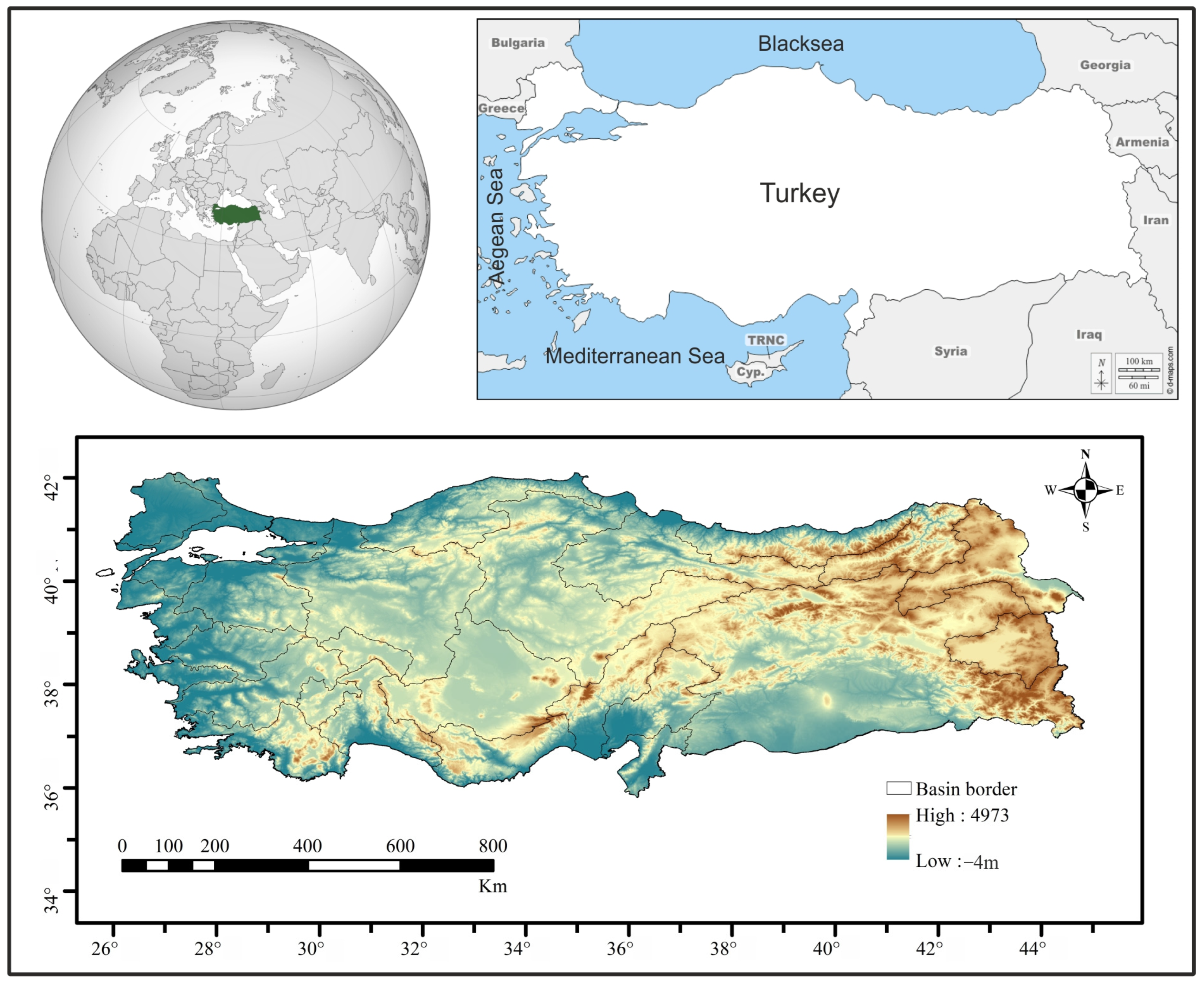
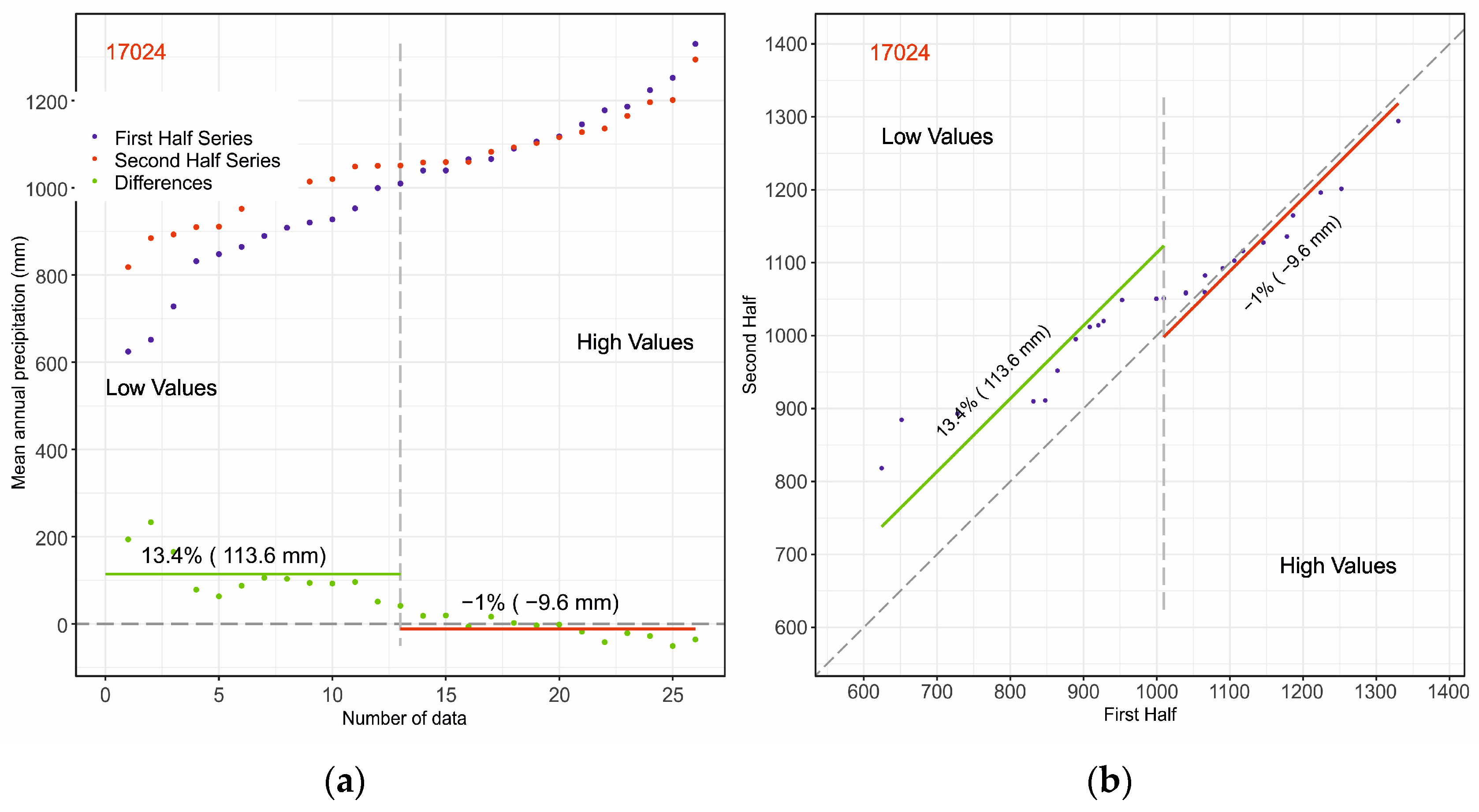
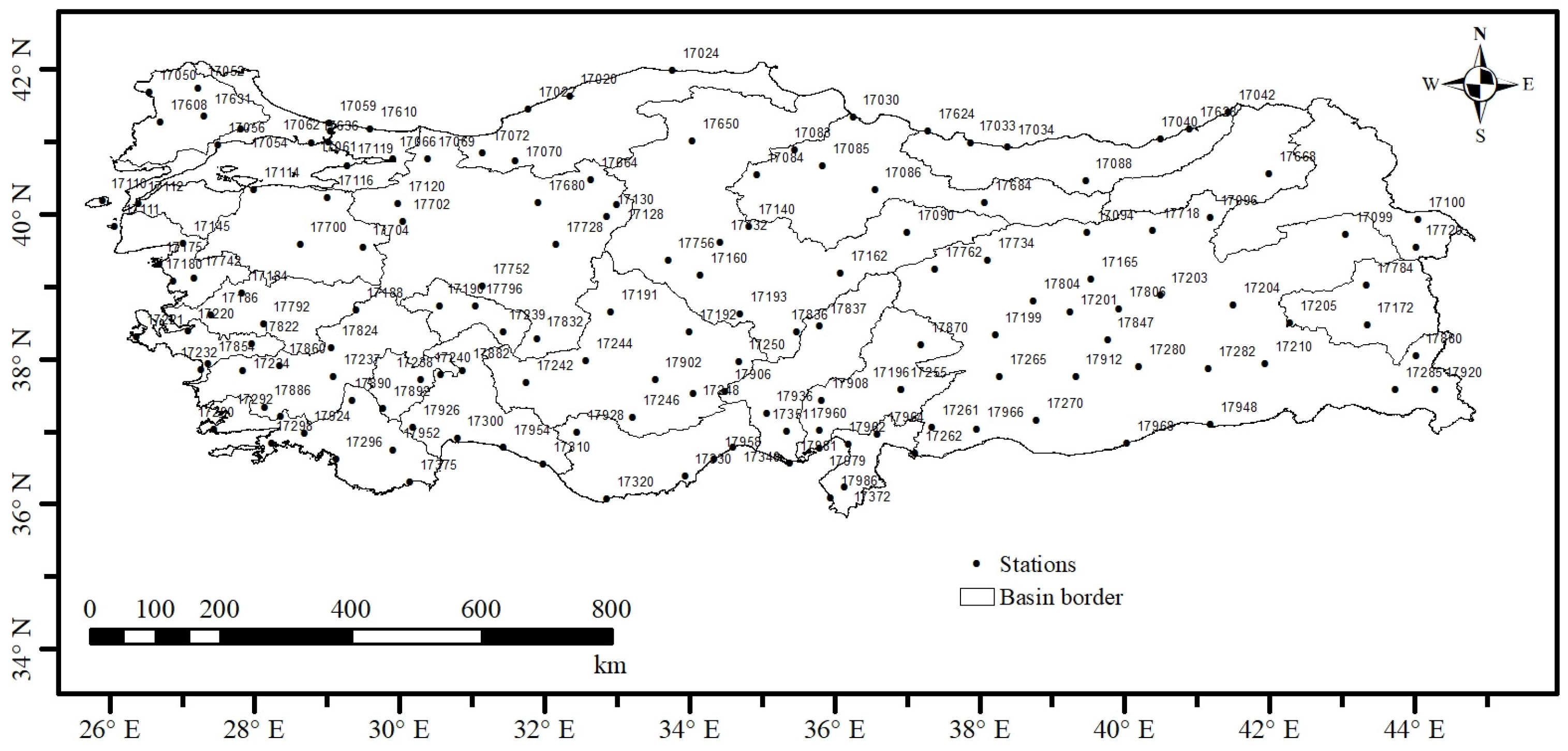
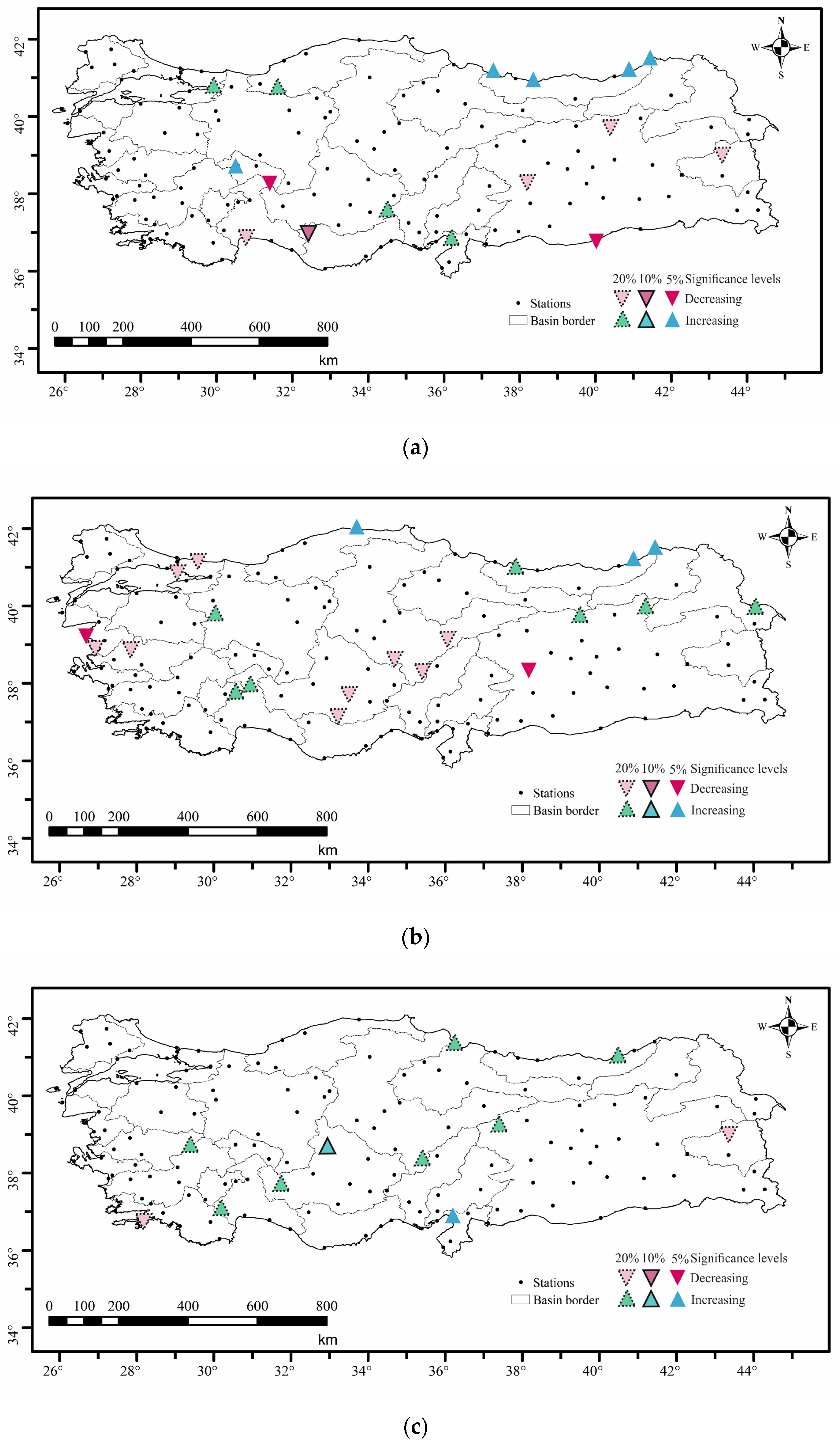
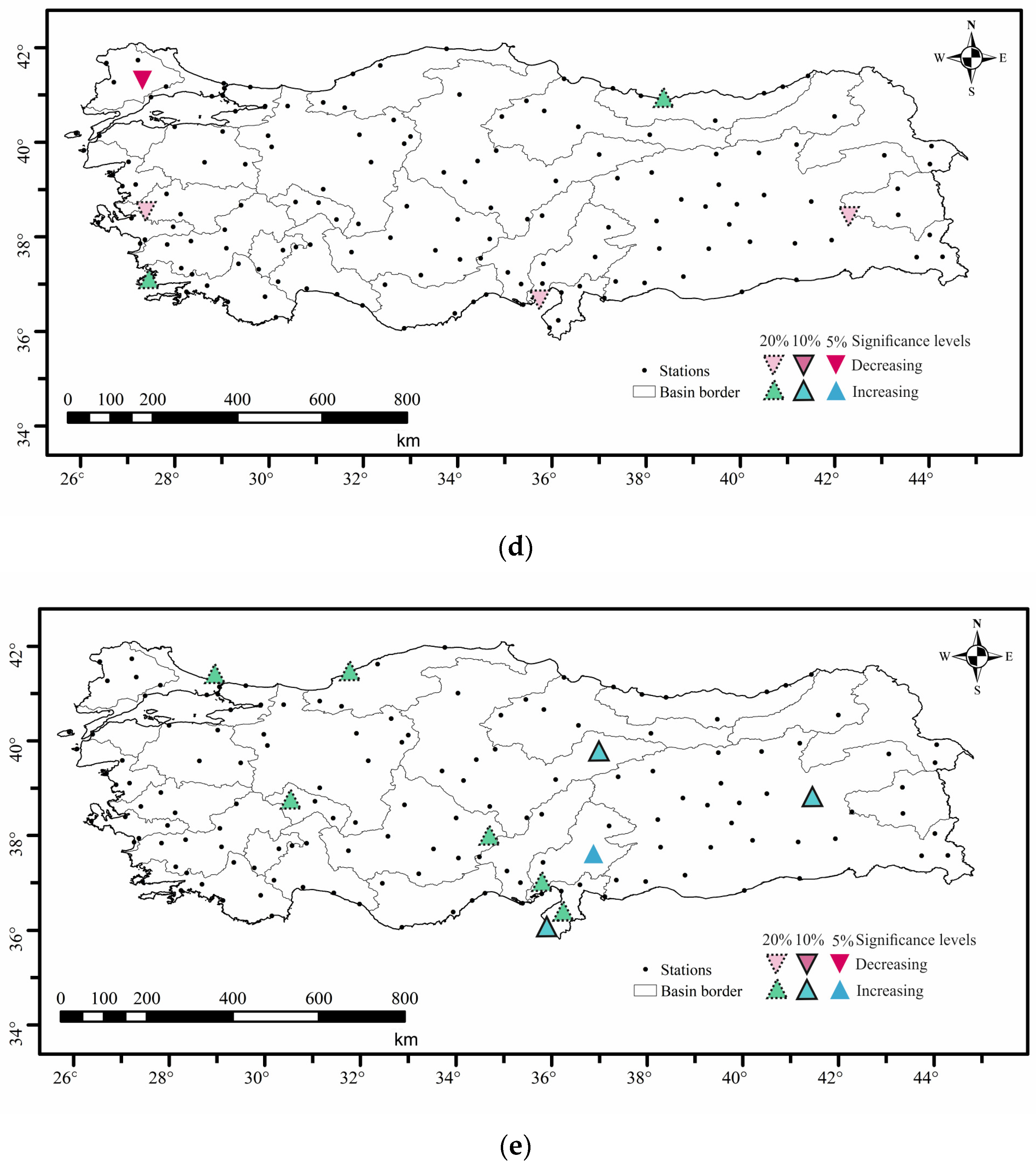
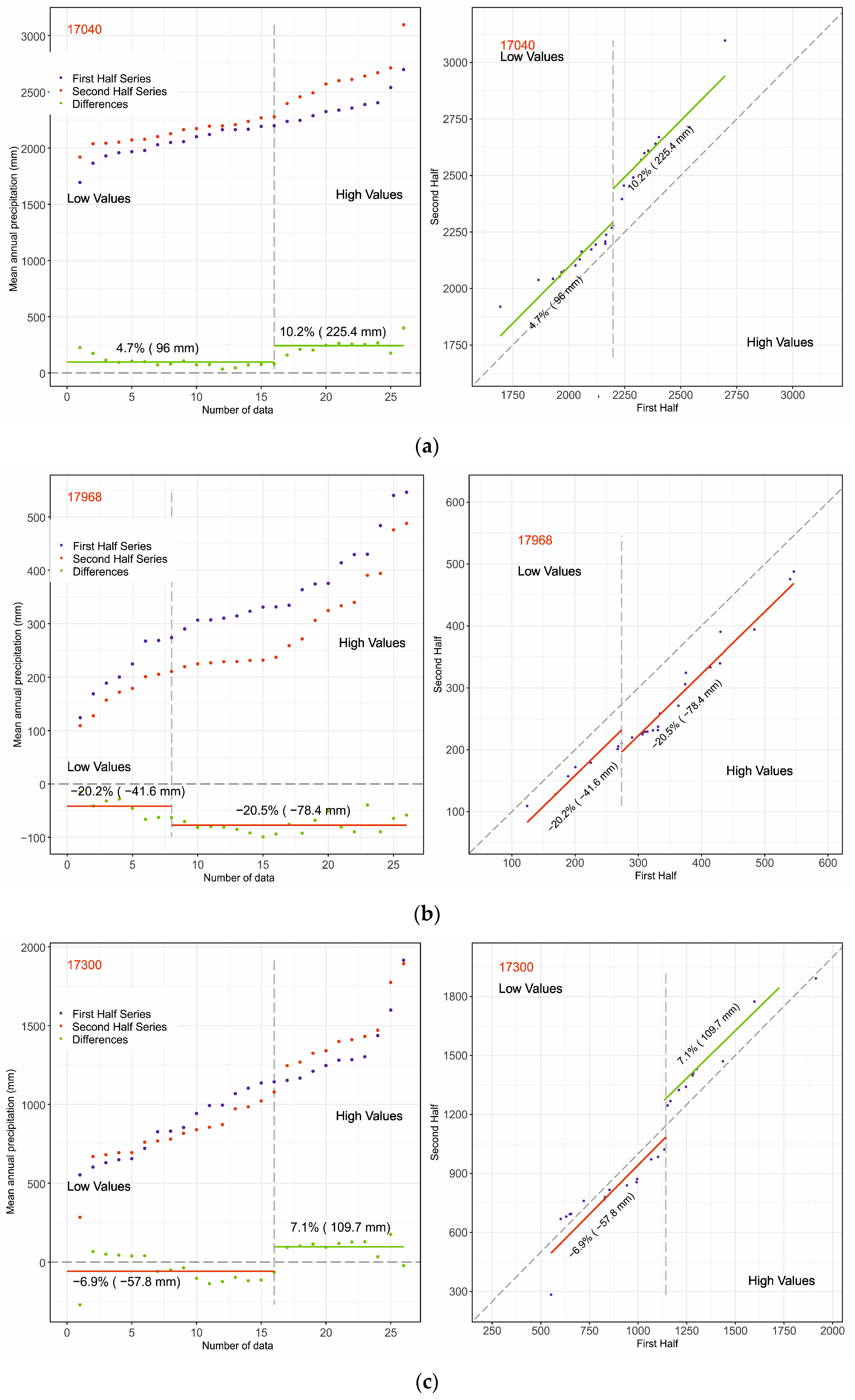
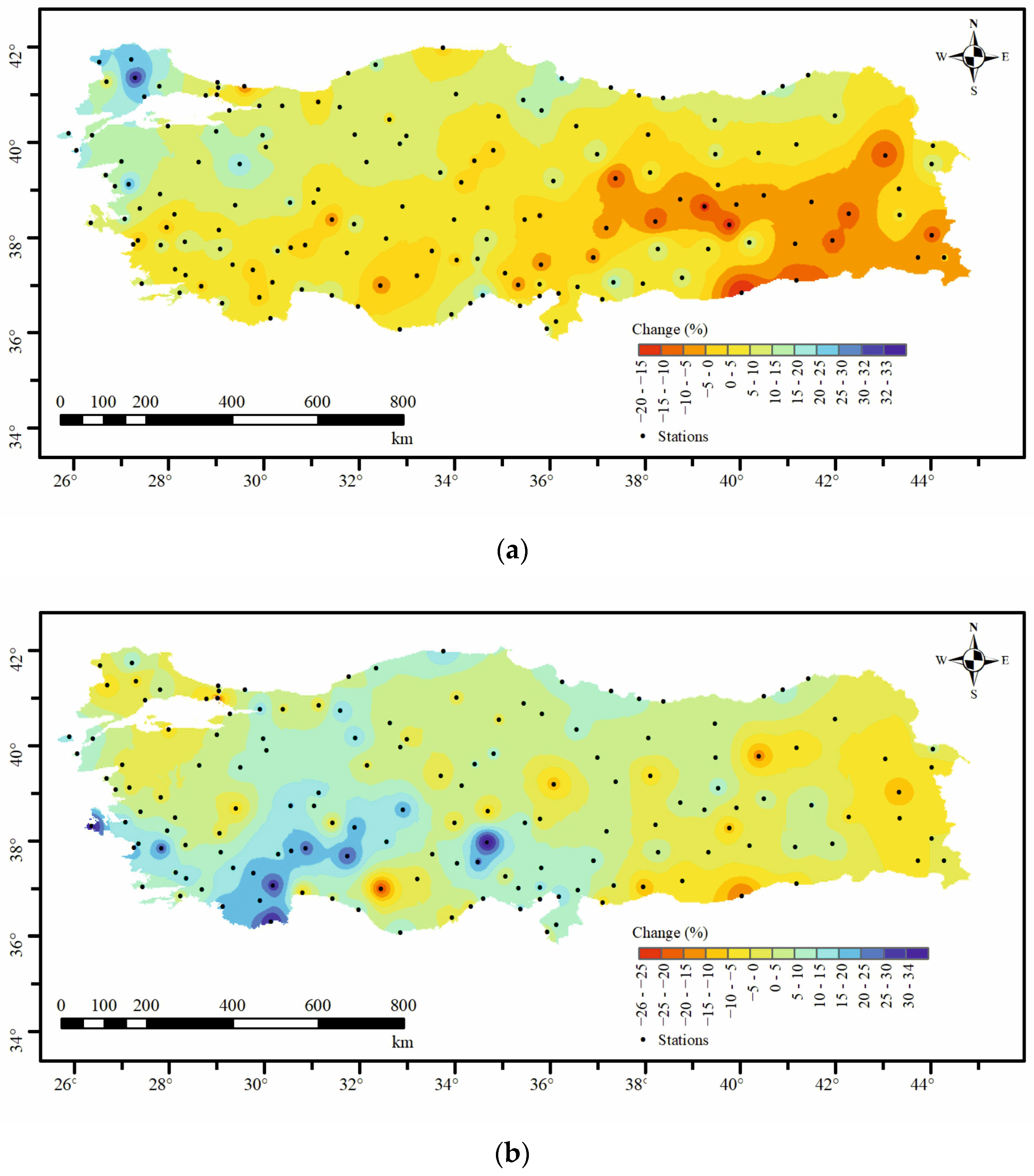
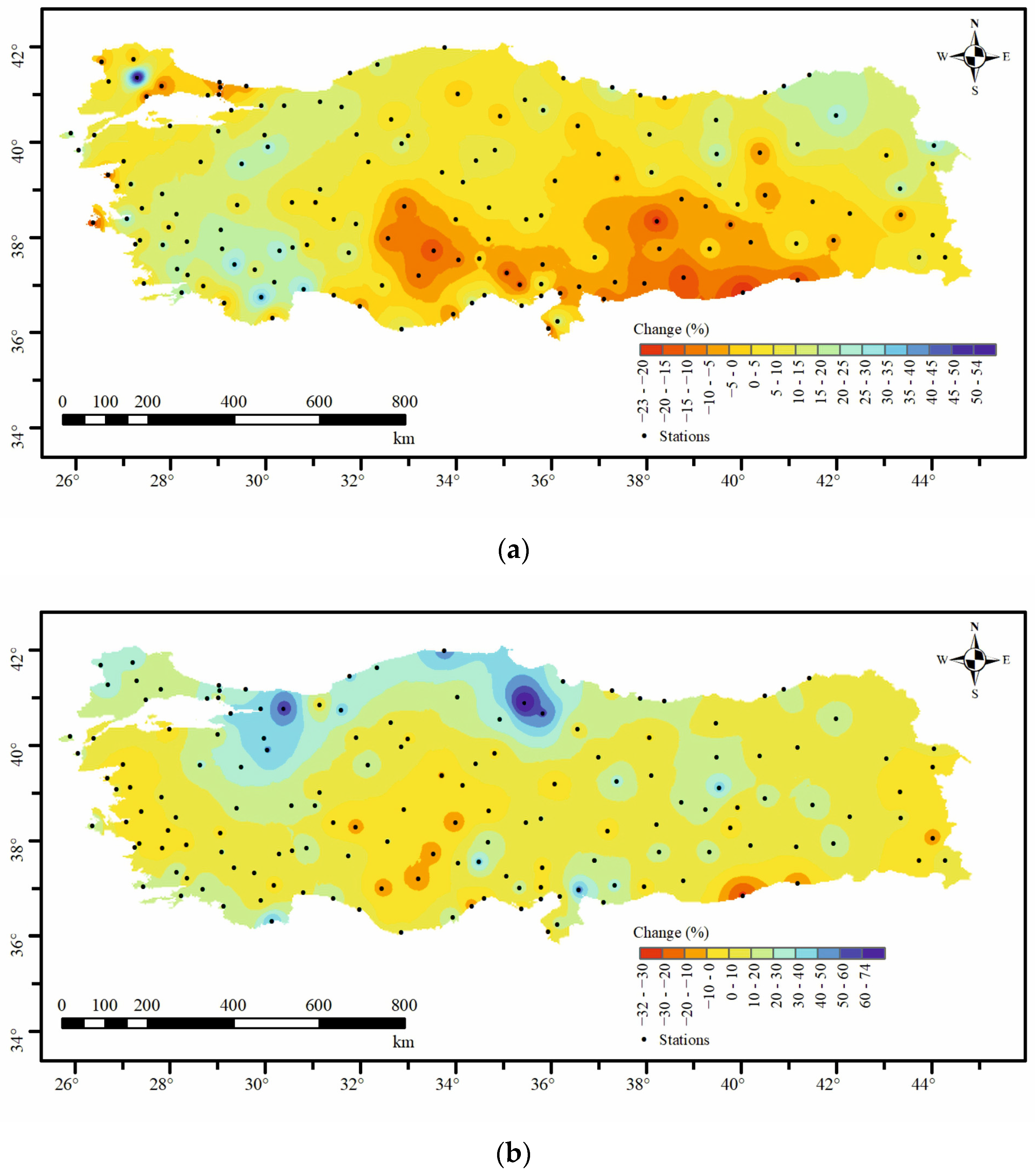
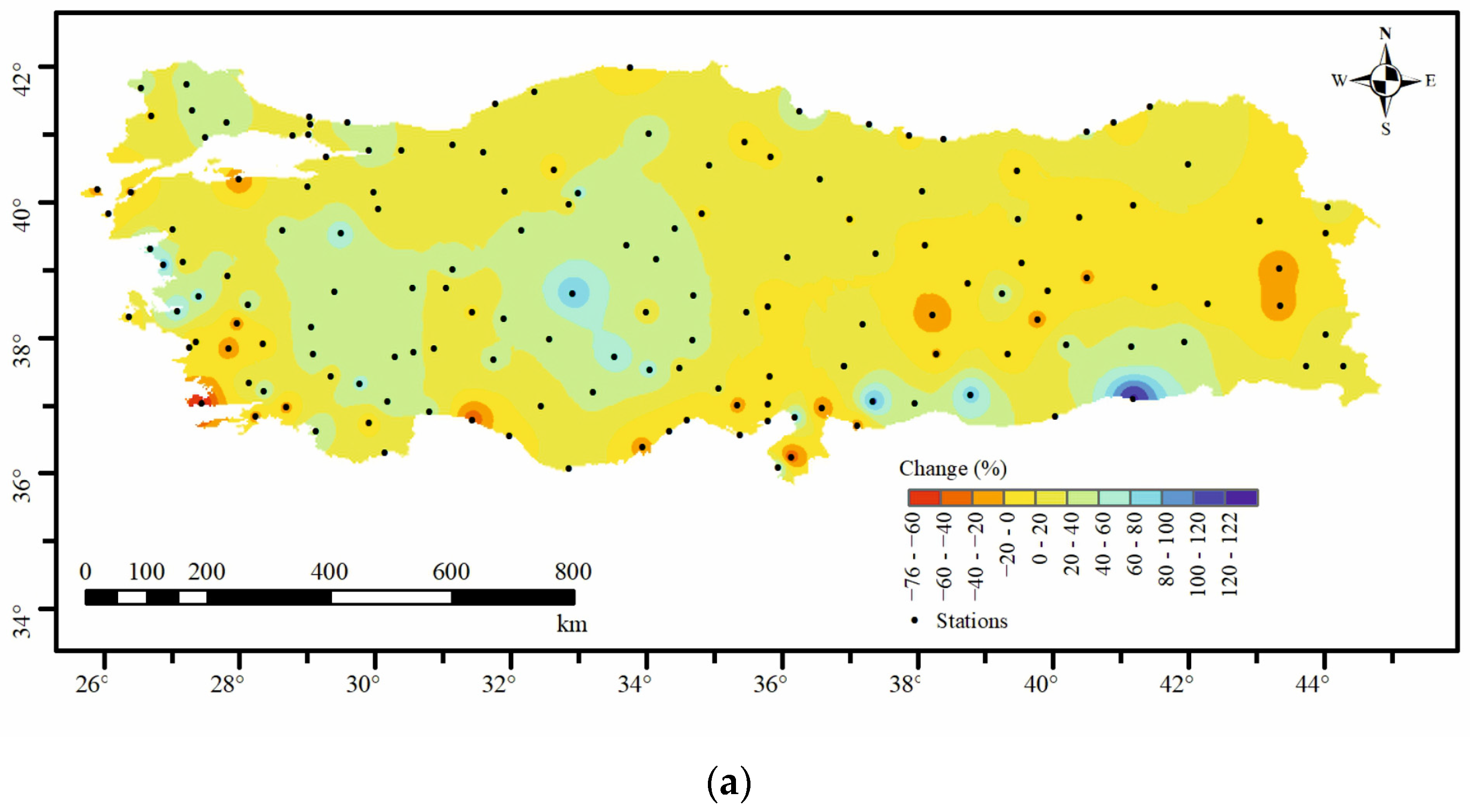
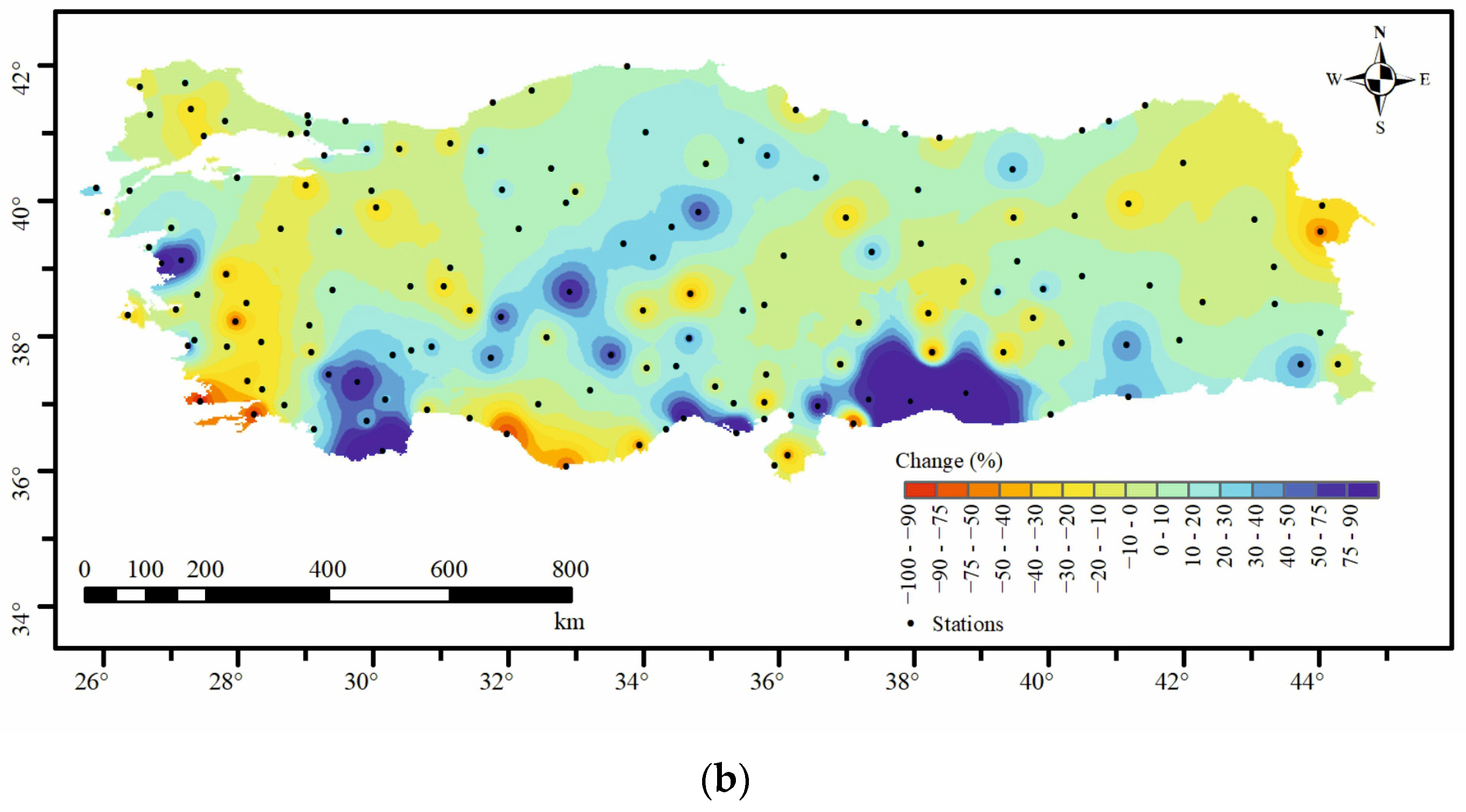
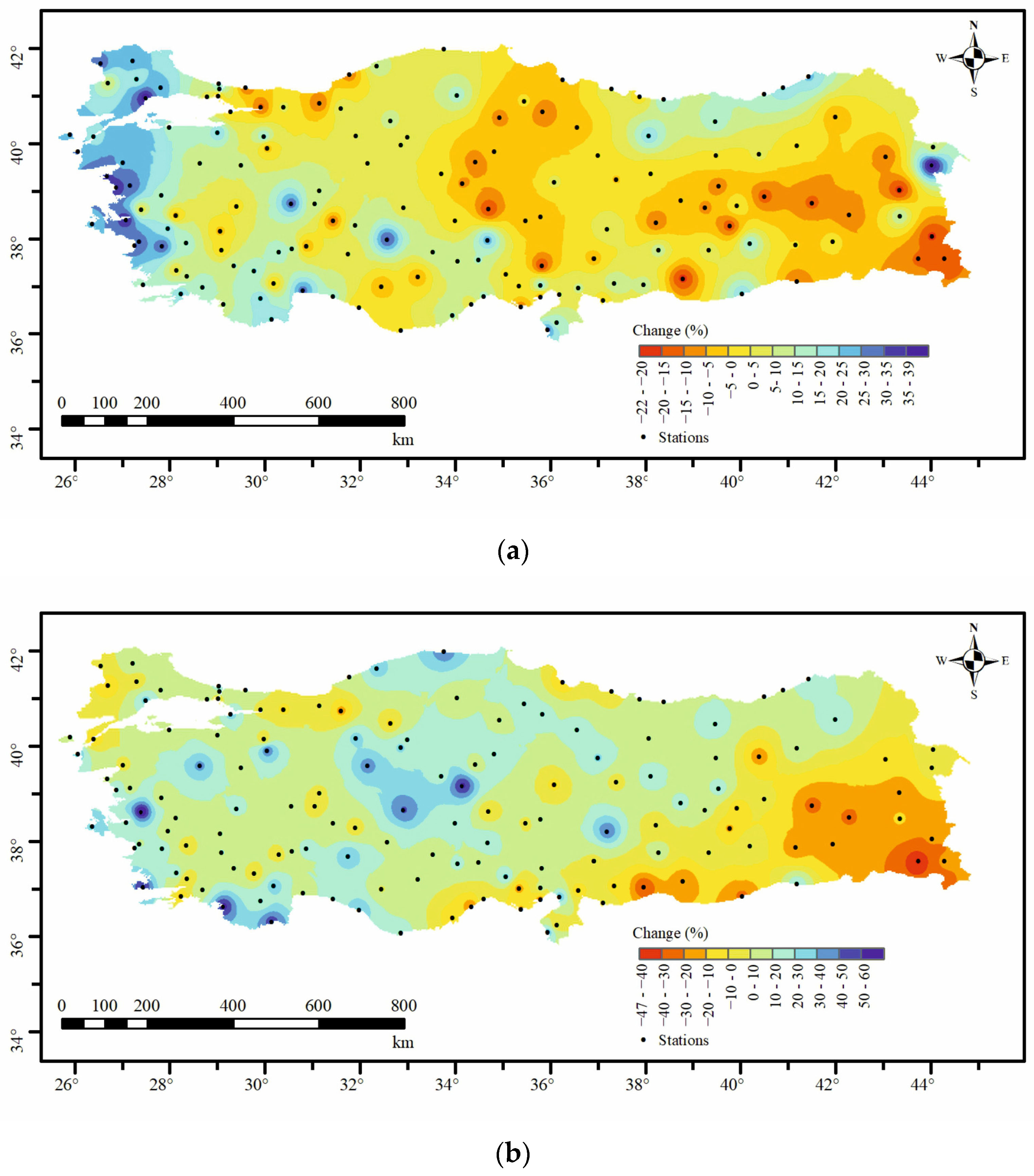
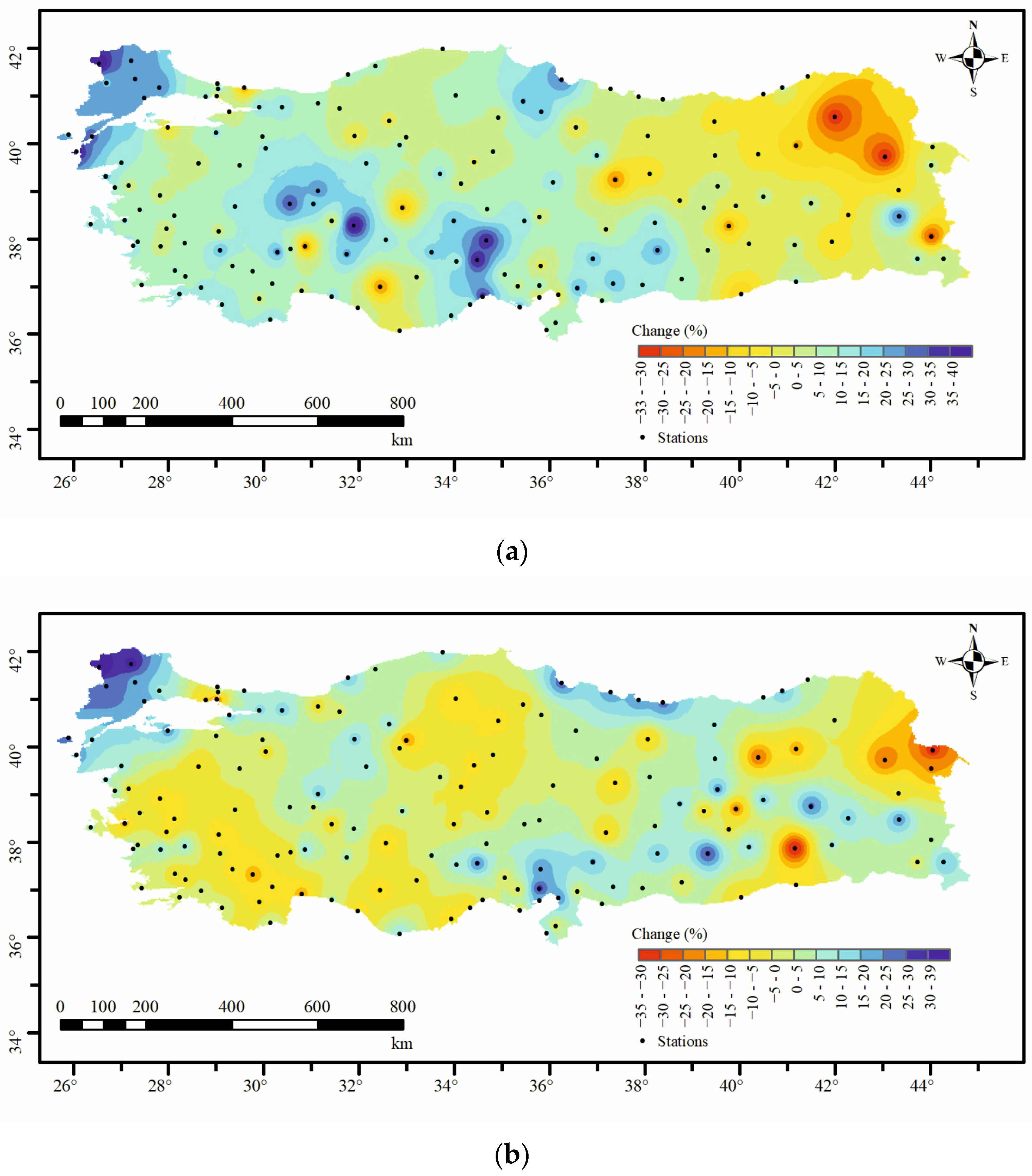
Disclaimer/Publisher’s Note: The statements, opinions and data contained in all publications are solely those of the individual author(s) and contributor(s) and not of MDPI and/or the editor(s). MDPI and/or the editor(s) disclaim responsibility for any injury to people or property resulting from any ideas, methods, instructions or products referred to in the content. |
© 2023 by the author. Licensee MDPI, Basel, Switzerland. This article is an open access article distributed under the terms and conditions of the Creative Commons Attribution (CC BY) license (https://creativecommons.org/licenses/by/4.0/).
Share and Cite
Nacar, S. Trends of High and Low Values of Annual and Seasonal Precipitation in Turkey. Sustainability 2023, 15, 16523. https://doi.org/10.3390/su152316523
Nacar S. Trends of High and Low Values of Annual and Seasonal Precipitation in Turkey. Sustainability. 2023; 15(23):16523. https://doi.org/10.3390/su152316523
Chicago/Turabian StyleNacar, Sinan. 2023. "Trends of High and Low Values of Annual and Seasonal Precipitation in Turkey" Sustainability 15, no. 23: 16523. https://doi.org/10.3390/su152316523
APA StyleNacar, S. (2023). Trends of High and Low Values of Annual and Seasonal Precipitation in Turkey. Sustainability, 15(23), 16523. https://doi.org/10.3390/su152316523





